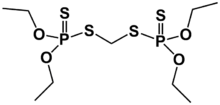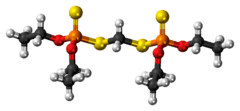Ethion
 | |
 | |
| Names | |
|---|---|
| IUPAC name
O,O,O′,O′-Tetraethyl S,S′-methylene bis(phosphorodithioate) | |
| Other names
Diethion;[(Dethoxyphosphinothioylthio)methylthio]-diethoxy-thioxophosphorane | |
| Identifiers | |
| 563-12-2 | |
| 3D model (Jmol) | Interactive image |
| ChEBI | CHEBI:38663 |
| ChemSpider | 3171 |
| ECHA InfoCard | 100.008.403 |
| KEGG | C18725 |
| PubChem | 3286 |
| UNII | 2TI07NO12Y |
| |
| |
| Properties | |
| C9H22O4P2S4 | |
| Molar mass | 384.48 g/mol |
| Appearance | Colorless to amber-colored, odorless liquid |
| Density | 1.22 g/cm3 |
| Melting point | −12.2 °C (10.0 °F; 260.9 K) |
| Boiling point | 150 °C (302 °F; 423 K) (decomposes) |
| 0.0001% (20°C)[1] | |
| Vapor pressure | 0.0000015 mmHg (20°C)[1] |
| Hazards | |
| Main hazards | Combustible[2] |
| Flash point | 176.1 °C (349.0 °F; 449.2 K) |
| US health exposure limits (NIOSH): | |
| PEL (Permissible) |
none[1] |
| REL (Recommended) |
TWA 0.4 mg/m3 [skin][1] |
| IDLH (Immediate danger) |
N.D.[1] |
| Except where otherwise noted, data are given for materials in their standard state (at 25 °C [77 °F], 100 kPa). | |
| | |
| Infobox references | |
Ethion (C9H22O4P2S4) is an organophosphate insecticide. Ethion is known to affect a neural enzyme called acetylcholinesterase and prevent it from working.
Review
Ethion was one of many substances that were approved for use based on data from Industrial Bio-Test Laboratories, which prompted the Food and Agriculture Organization and World Health Organization to recommend its reanalysis in 1982.[3]
References
- 1 2 3 4 5 "NIOSH Pocket Guide to Chemical Hazards #0257". National Institute for Occupational Safety and Health (NIOSH).
- ↑ CDC - NIOSH Pocket Guide to Chemical Hazards
- ↑ "Pesticide Residues in Food", Data and recommendations of the joint meeting of the FAO Panel of Experts on Pesticide Residues in Food and the Environment and the WHO Expert Group on Pesticide Residues, Rome: Food and Agriculture Organization of the United Nations, 2 December 1982, retrieved 2012-07-16
External links
- "Ethion - Identification, toxicity, use, water pollution potential, ecological toxicity and regulatory information". Pesticide Action Network North America. Retrieved March 20, 2016.
This article is issued from Wikipedia - version of the 3/21/2016. The text is available under the Creative Commons Attribution/Share Alike but additional terms may apply for the media files.